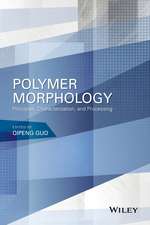Applied Polymer Light Microscopy
Editat de Derek A. Hemsleyen Limba Engleză Paperback – 20 mar 2012
Preț: 387.58 lei
Nou
Puncte Express: 581
Preț estimativ în valută:
74.17€ • 76.62$ • 61.73£
74.17€ • 76.62$ • 61.73£
Carte tipărită la comandă
Livrare economică 26 martie-09 aprilie
Preluare comenzi: 021 569.72.76
Specificații
ISBN-13: 9789401174763
ISBN-10: 9401174768
Pagini: 300
Ilustrații: XII, 282 p.
Dimensiuni: 152 x 229 x 16 mm
Greutate: 0.4 kg
Ediția:Softcover reprint of the original 1st ed. 1989
Editura: SPRINGER NETHERLANDS
Colecția Springer
Locul publicării:Dordrecht, Netherlands
ISBN-10: 9401174768
Pagini: 300
Ilustrații: XII, 282 p.
Dimensiuni: 152 x 229 x 16 mm
Greutate: 0.4 kg
Ediția:Softcover reprint of the original 1st ed. 1989
Editura: SPRINGER NETHERLANDS
Colecția Springer
Locul publicării:Dordrecht, Netherlands
Public țintă
ResearchCuprins
1 Specimen Preparation.- 1.1 Introduction.- 1.2 Initial Approach to Preparing the Specimen.- 1.3 Area of the Specimen.- 1.4 Surfaces.- 1.5 Sectioning (Sectional Slices).- 1.6 Melt Pressings.- 1.7 Staining.- 1.8 Final Comments.- 2 Basic Light Microscopy and the Phase Contrast Microscope.- 2.1 Introduction.- 2.2 Synthetic Polymers as Specimens for Light Microscopy.- 2.3 Light versus Electron Microscopy of Polymers.- 2.4 Basic Light Microscopy.- 2.5 Applications for Common Light Microscopy.- 2.6 Phase Contrast Microscopy ..- 2.7 Applications for Phase Contrast Microscopy.- 2.8 Dark Ground Microscopy.- References.- 3 Polarized Light: Theory and Measurements.- 3.1 Introduction.- 3.2 Light and Its Interaction with Matter.- 3.3 Elliptically and Circularly Polarized Light.- 3.4 The Uniaxial Indicatrix.- 3.5 The Biaxial Indicatrix.- 3.6 Methods of Producing Polarized Light.- 3.7 Types of Birefringence.- 3.8 The Passage of Polarized Light through Thin Birefringent Plates.- 3.9 Polarization Colours.- 3.10 Relation between Orientation and Birefringence.- 3.11 The Polarizing Microscope.- 3.12 Measurement of Optical Path Difference.- 3.13 Compensators.- 3.14 Dispersion of Birefringence.- 3.15 Spectrophotometric Method.- 3.16 The Wedge Method.- 3.17 Use of the Abbé Refractometer.- References.- 4 Polarized Light: Qualitative Microscopy.- 4.1 Introduction.- 4.2 Spherulites.- 4.3 Theory of Spherulitic Crystallization.- 4.4 Different Types of Spherulite.- 4.5 Spherulitic Forms of Polypropylene.- 4.6 Effect of Processing on Spherulites.- 4.7 Small Angle Light Scattering.- 4.8 Molecular Orientation.- References.- 5 Modulation Contrast and Differential Interference Contrast Techniques.- 5.1 Introduction.- 5.2 General Principles.- 5.3 The Modulation Contrast System.- 5.4 DifferentialInterference Contrast.- 5.5 Adjusting the Contrast Systems.- 5.6 Comparison with the Phase Contrast Microscope.- 5.7 Reflected Light Work.- 5.8 Image Interpretation.- 5.9 Applications to Polymers.- References.- 6 Interference Microscopy of Polymers.- 6.1 Introduction.- 6.2 The Basic Principles of Quantitative Microinterferometry.- 6.3 Reflected Light Applications.- 6.4 Interpretation of Surface Interferograms.- 6.5 Some Reflected Light Systems Applicable to Polymers.- 6.6 Transmitted Light Interference Microscopy.- 6.7 Transmitted Light Systems.- 6.8 Compensators.- References.- 7 Ultraviolet and Fluorescence Microscopy.- 7.1 Introduction.- 7.2 Equipment and Techniques.- 7.3 Applications to Non-polymer Materials.- 7.4 Non-Microscopic Applications of Fluorescence from Polymers.- 7.5 Applications of UV Microscopy to Synthetic Polymers.- References.









